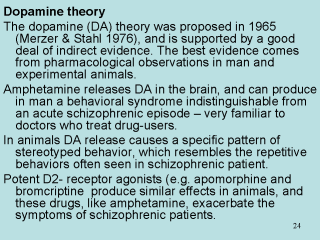| front |1 |2 |3 |4 |5 |6 |7 |8 |9 |10 |11 |12 |13 |14 |15 |16 |17 |18 |19 |20 |21 |22 |23 |24 |25 |26 |27 |28 |review |
 |
Furthermore, DA
antagonists and drugs that block neuronal DA storage (e.g. reserpine) are effective in
controlling the positive symptoms of schizophrenia, and preventing amphetamine-induced
behavioral changes. There is a strong correlation between clinical antipsychotic potency
and activity in blocking D2-receptors, and receptor imaging studies have shown that
clinical efficacy of antipsychotic drugs is consistently achieved when D2- receptors
occupancy reaches about 80%. There are many another evidences of DA theory and some contradictions of it. A well-controlled study by Reynolds (1983) however, showed a raised DA content post-mortem in amygdala of schizophrenic subjects, the NA content being normal. Most surprisingly the increased DA content was confined to the left side of the brain, which makes it most unlikely that it could have been the result of antipsychotic drug treatment. Recent studies have shown that DA release may be increased in schizophrenic compared with control subjects (Laruelle et al.1996). The role of DA in CNS and DA-ergic pathways see upper. The DA4- receptor has also attracted attention on account of the high degree of genetic polymorphism that it shows in human subjects, and because some of the newer antipsychotic drugs (e.g. clozapine) turn out to have a high affinity for this receptor subtype. |
| front |1 |2 |3 |4 |5 |6 |7 |8 |9 |10 |11 |12 |13 |14 |15 |16 |17 |18 |19 |20 |21 |22 |23 |24 |25 |26 |27 |28 |review |